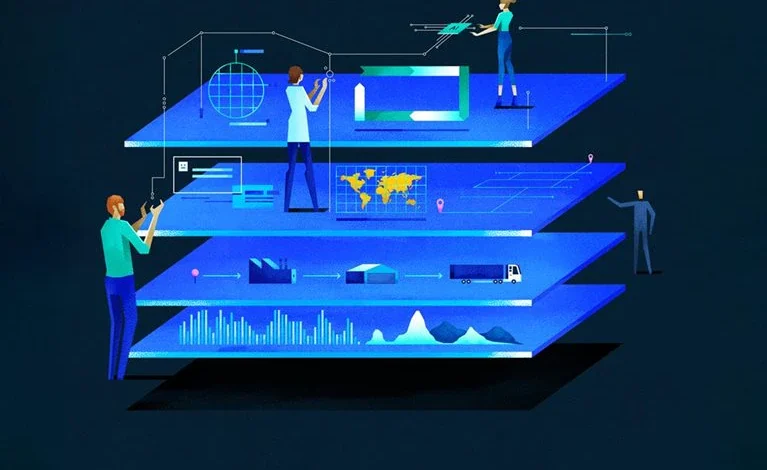
Companies have strained at every level to react to recent changes in supply chain environments. Now, attention turns to how to use AI-powered solutions to strengthen operations and make them more resilient. This means being able to move faster in a crisis context and also creating a supply chain that can bend without breaking.
AI enhances the digital twin approach
The combination of AI and digital twins is almost irresistibly powerful. AI, particularly generative AI (Gen AI) and machine learning (ML), significantly enhances the functionality of digital twins, enabling them to process ever-larger volumes of data, support more detailed pattern identification, and provide actionable insights for decision making. When combined with predictive AI, digital twins can also enable more granular and industry- or company-specific predictions.
Furthermore, generative AI uses real-time data to create dynamic inputs for digital twins, improving their ability to simulate and optimize processes. One way that GenAI is transforming digital twins is through Agentic AI, which pairs the powers of GenAI with automation and orchestration of end-to-end digital twins. Read more about this powerful pairing here.
From crisis to BAU
For many, the supply chain business conversation now moves beyond emergency reaction and reorganization to a discussion of how resilience can be incorporated at the heart of business models. Markets and operations, after all, are likely to remain fluid and changeable due to higher levels of geopolitical risk and sustained technological advancement.
Digital twins provide end-to-end visibility across the supply chain and unlock autonomous sense-and-respond capabilities for rapid reaction to issues often well in advance of human detection. But digital twins also enable companies to move beyond reactive solutions and design supply chains with resilience at their core. They allow businesses to anticipate vulnerabilities and build in contingencies before disruptions occur. With the right technology, people, and ways of working in place, the next great reorganization and reaction should not feel like a crisis, but more like business as usual.
Scenarios, silos, and systems
Digital twins are virtual replicas of an object, system, or process that can be used to simulate potential situations and outcomes. A successful and widely adopted digital twin will also provide end-to-end visibility of operations, a safe space for experimentation, and a system that optimizes operations, breaking down silos in the process. Paired with today’s advances in predictive AI, digital twins can become both predictive and prescriptive. They can help predict future scenarios to demonstrate areas for improvement or growth, ultimately leading to a self-monitoring and self-healing supply chain.
A winning power of digital twins lies in their ability to simulate a wide range of potential disruptions before they happen. By using AI to model different scenarios (geopolitical instability, climate events, unexpected demand surges), companies can stay well ahead of the game by identifying weak points and proactively adjusting their operations.
Perhaps most fundamentally, digital twins also help to break down the traditional silos within supply chains by connecting the wide array of supply chain management (SCM) tools in play, providing a holistic view of the entire network. Such end-to-end visibility is crucial for identifying cascading risks and optimizing the whole system, not just individual components. Furthermore, when decision makers at all levels can visualize potential risks and trade-offs, the entire organization is strengthened as people begin to make decisions to support supply chain resilience. Strength and flexibility become a core feature, not just a top-down project.
A resilience premium
Forward-looking leaders will see implementing digital twins as an investment rather than a cost. Indeed, we would suggest that a clear value case and self-funding road map should be a prerequisite for the corporate decision maker investing in a digital twin. The investment yields a “resilience premium” derived from reduced downtime, faster recovery times, increased customer loyalty due to more reliable fulfillment, and the ability to capitalize on opportunities that competitors miss due to their lack of preparedness.
Of course, and as always, it takes more than just the software to convert these opportunities. Building resilient supply chains with digital twins requires new process design to leverage the technology and a new breed of talent—individuals who understand both the technical aspects of AI and data modeling and the operational realities of modern supply chain management. Companies have a job to do in the realms of training, development, recruitment, and retention to bridge this skills gap.
Practical steps toward digital twins
We’re entering an era when digital twins are no longer a shiny tool for optimization, but a strategic imperative for building truly resilient supply chains in an increasingly unpredictable world. Near-term steps that leaders can take as they pursue digital twins include:
- Identifying where silos in the business are driving sub-optimal decisions. For example, where savings on manufacturing costs are directly and disproportionally increasing logistics costs
- Identifying where in the organization decisions are being made based on intuition, not data
- In the identified areas, introduce a re-designed process and metric system to encourage breaking down silos and more data-driven decisioning
- In parallel, build your roadmap of digital use cases to pair with the new processes
Read more about how digital twins can power growth and stronger supply chain resilience here.





